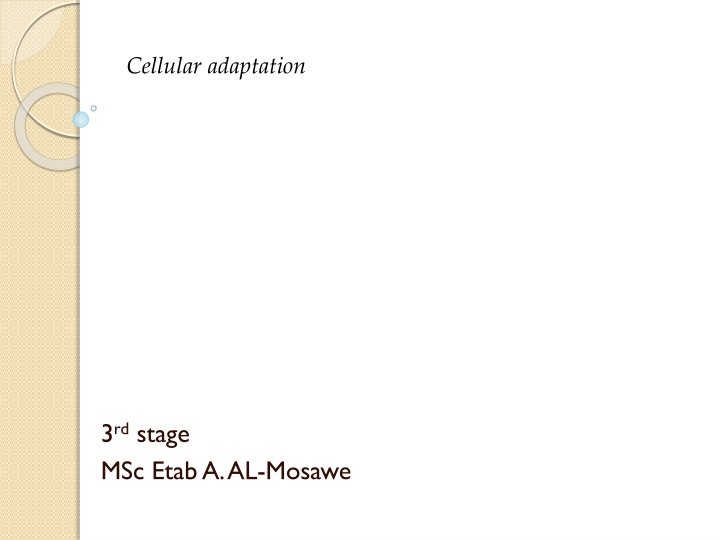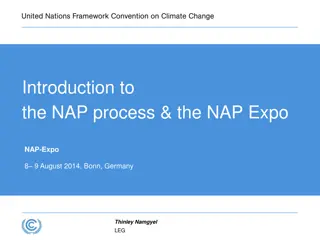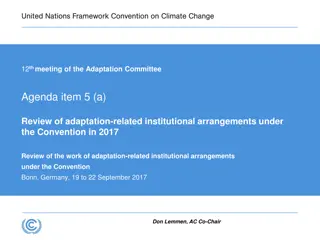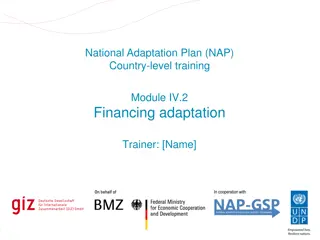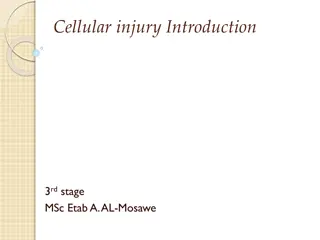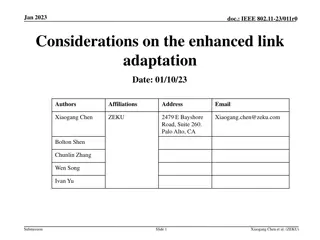Cellular Adaptation: Types and Examples
The process of cellular adaptation involves changes in size, number, or type of cells. Learn about atrophy, hypertrophy, hyperplasia, metaplasia, and dysplasia with real-life examples. Explore images showcasing cellular changes in organs such as the kidney, heart, and prostate due to various adaptations.
Download Presentation

Please find below an Image/Link to download the presentation.
The content on the website is provided AS IS for your information and personal use only. It may not be sold, licensed, or shared on other websites without obtaining consent from the author.If you encounter any issues during the download, it is possible that the publisher has removed the file from their server.
You are allowed to download the files provided on this website for personal or commercial use, subject to the condition that they are used lawfully. All files are the property of their respective owners.
The content on the website is provided AS IS for your information and personal use only. It may not be sold, licensed, or shared on other websites without obtaining consent from the author.
E N D
Presentation Transcript
Cellular adaptation 3rdstage MSc EtabA. AL-Mosawe
Cellular adaptation This process of adaptation can involve changes in cellular size, number or type. 1. Atrophy , Decrease in size of a cell or tissue. Atrophy is generally a reversible process, except for atrophy caused by loss of nervous innervation to a tissue. Hypertrophy , Increase in cell size and tissue mass. Hyperplasia , Increase in the number of cells in an organ or tissue. Can only occur in cells capable of mitosis (therefore, not muscle or nerve cells). 2. 3. 4. Metaplasia , The conversion of one cell type to another cell type 5. Dysplasia ,A derangement of cell growth that leads to tissues with cells of varying size, shape and appearance.
19-There is a relatively normal kidney at the left with only a few scattered, shallow cortical scars and one fairly large pale tan-yellow scar in the upper pole. The right kidney is atrophic because of renal arterial occlusion. Such a situation can lead to hypertension (Goldblatt kidney).
20-Heart with hypertrophy:It is an increase in the size of a tissue or organ with out an increase in the number of cells. large cells or organ. The left ventricle is markedly thickened in this patient with severe hypertension that was untreated for many years. The myocardial fibers have undergone hypertrophy.
21-A normal prostate gland is about 3 to 4 cm in diameter. This prostate is enlarged due to prostatic hyperplasia, which appears nodular. Thus, this condition is termed either BPH (benign prostatic hyperplasia) or nodular prostatic hyperplasia.
22-The enlarged prostate has glandular hyperplasia. The glands are well-differentiated and still have some intervening stroma. The small laminated pink concretions within the glandular lumens are known as corpora amylacea.
23-Metaplasia:It is the transformation of one type of tissue in to another of the same original primary tissue, it seen in epithelial tissue or C .T. metaplasia the cell itself does not undergo transformation, but rather the new cells in the area appear as a replacement of a different cell type. In
24-This is cervical squamous dysplasia at high magnification extending from the center to the right. The epithelium is normal at the left. Note how the dysplastic cell nuclei are larger and darker, and the dysplastic cells have a disorderly arrangement.
